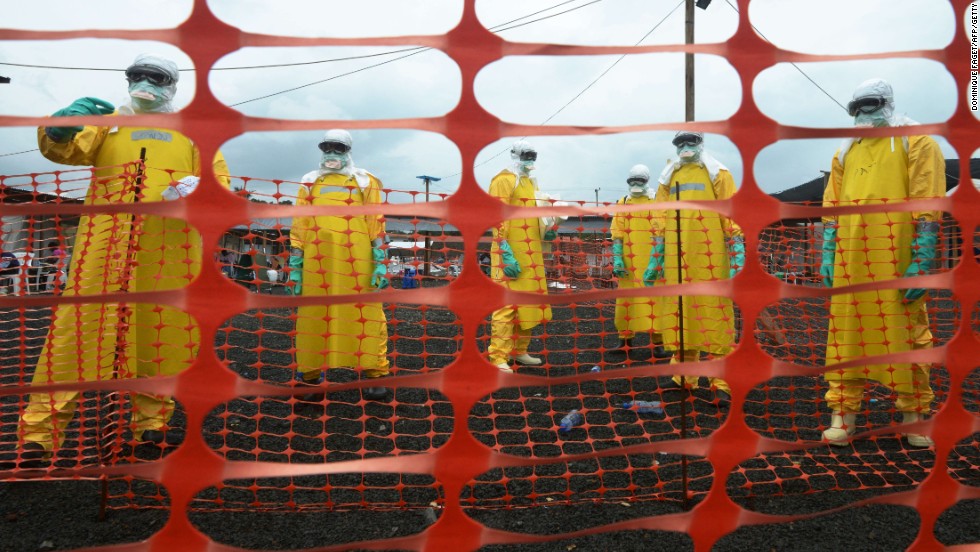 Workers wear protective gear at a Monrovia, Liberia, hospital handling Ebola cases in September.
Workers wear protective gear at a Monrovia, Liberia, hospital handling Ebola cases in September.Here's the fascinating research we're watching from around the world. CNN Health & Wellness has gauged these studies' impact on our health:
Ebola vaccine shows success in protecting monkeys
A needle-free vaccine has proven to protect monkeys against the Ebola virus. According to The Journal of Clinical Investigation,
researchers successfully vaccinated monkeys against the Zaire
ebolavirus, responsible for the current outbreak in West Africa. It is
the first published test of aerosol delivery for an Ebola vaccine, which
uses a nebulizer to change liquid into a mist that's inhaled into the
lungs. While the vaccine was effective in protecting primates against
Ebola, there's no guarantee it will work as well in humans.
The
next step? A clinical trial in humans,
according to the study's
authors. Since training isn't necessary for administering an inhaled
vaccine, a successful version would be especially useful in remote areas
that lack adequate health systems.
Lyme disease spreading in U.S.
Pop star Avril Lavigne isn't the only person battling Lyme disease.
This infection, which develops from a tick bite containing the bacteria
Borrelia burgdorferi, is spreading across the Northeastern,
mid-Atlantic and north-central United States, according to a report from the Centers for Disease Control and Prevention.
Looking
at cases of Lyme disease from 1993 to 2012, researchers found the
tick-borne illness is expanding geographically at a consistent rate in
all directions outward. The exact cause of the expanding human
infections isn't known but might be due to changing weather patterns and
the migration of birds or deer, which can unknowingly carry infected
ticks.
Should you be worried? "Ticks
love forests. If you live near forested areas or wildlife, you're at an
increased risk. Places like Manhattan -- not so much," said lead study
author and CDC epidemiologist Kiersten Kugeler.
Here are four simple steps
to beat tick bites from happening: Use repellent with DEET outdoors,
check your body daily, shower after spending time outside and seek
health care if you develop a fever.
Why young women light up
While pack-a-day smokers have been on the decline since the 1960s, light smoking is still popular among young adult women. A new report from the CDC's Preventing Chronic Disease
says that almost a fifth of nearly 10,000 women ages 18 to 25 surveyed
were very light smokers. These women -- who smoked no more than five
cigarettes a day -- were also more likely than other surveyed female
smokers to be young, unmarried, part of a minority group and have some
form of college education.
While the study said young women were aware of the health dangers of smoking, factors such as the high cost of cigarettes and weekend partying in college also were shown to influence light smoking.
Wildfires are also bad for your heart
Homes aren't the only things to which wildfires pose a threat. You also need to be concerned about your heart, says a report
in the Journal of the American Heart Association. While respiratory
problems were a result of wildfire exposure previously, new research
shows a nearly 7% increased risk for cardiac arrest after pollutant
exposure.
Researchers in Australia
conducted the study between December 2006 and January 2007 when wildfire
smoke reached cities far from any blazes and air pollution levels
exceeded recommended limits. As wildfires continue to wreak havoc on the
U.S. West Coast and in other parts of the world, the study's authors
suggest watching pollution levels if you're near fires.
Funeral directors may be at increased risk of ALS
Funeral
directors are three times more likely to die from amyotrophic lateral
sclerosis, or ALS, than other types of workers, according to a recent study. Harvard researchers uncovered a link between occupational exposure to the preserving chemical formaldehyde and ALS, a progressive neurodegenerative disease.
Previous
research has attributed formaldehyde to nerve damage, which is
responsible for ALS symptoms. Those findings led researchers to compare
deaths from ALS across different occupations that expose people to
formaldehyde.
According to the new
study, funeral directors are more susceptible because they're exposed
frequently to intense amounts of formaldehyde when preparing bodies for
burial. Male funeral directors also died from ALS much more often than
female funeral directors, researchers found. They believe this gender
difference might be due to the fact that women funeral directors "are
more likely to interact with bereaved clients and less likely to perform
embalming," the study said.
No comments:
Post a Comment